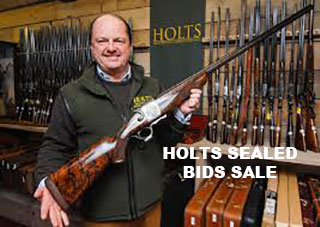The average salary in the UK today is £33,500. That will buy you nothing from any of the top British Gunmakers. If a side-by-side is what you seek, and this is your budget, you have two choices: buy secondhand or buy foreign.
If considering secondhand, rather than new, and seeking best quality in top condition, the British gun market offers remarkable value for money.
British guns are cheaper now than they were twenty years ago and with the prices of a new gun rising at alarming rates, the used market for the end-user, rather than the investor or speculator, is a great place to look.
My advise is to forget about making money on a gun purchase. Treat it as you would any other piece of machinery or sporting equipment. Buy it to use and write-off the cost over five years.

You will probably be pleasantly surprised when, or if, you eventually have to sell it. You will get some money back, possibly quite a lot. However, people who put money into classic guns over the last two decades expecting to cash-in a rising investment when they retired got a nasty shock.
Buy the kind of gun you want to use and enjoy - then use it and enjoy it.
Before we get into choices, a look at the performance of guns as investments over the last two decades is a useful exercise.
In 2012, the cost of a new Purdey side by side was £71,000 plus VAT. Today, it is £135,000 plus VAT.
In conversation with Paul Roberts (former owner of Rigby and veteran gun-dealer) a couple of years ago, he reflected on an advertisement he had found, that he had put in Shooting Times in the 1980s. Paul said he was selling good Purdey side-locks for £10,000-£15,000. At the time he was also driving a Ferrari, worth about the same money. Today, those Purdeys would still be £10,000-£15,000 but the Ferarri would be worth a quarter of a million pounds!

Hindsight is wonderful thing but history does provide useful perspective. I had my Webley Model 700 valued when I left to work abroad in 1988. The valuation was £600-£800. I still have it. If I put it into Bonham’s tomorrow, it would make £650, if recent results are a good indicator. By way of comparison, I wear a Rolex Submariner. In 1988 it was listed new at £1,080. Today, that watch, also auctioned at Bonham’s would comfortably sell for £6,000, possibly £8,000.
What I take from this data is that the true cost of good British secondhand guns has nose-dived. That makes them very good value if you consider purely the quality and they represent and stop trying to see them as a means of making a profit.
Unlike most other things we buy, best British guns are the same today as they were a century ago. Go to Rigby, Purdey, Holland & Holland, Westley Richards, W.W. Greener or John Dickson and you will get, essentially, the same gun the company would have handed their customers in 1923. So, the difference between a ten-year-old Holland & Holland ‘Royal’ and a fifty-year-old one is negligible.
If you are buying a ‘best’ gun, the original quality is assured. Even if you are buying a second, third or fourth quality gun, it will be a well-made and reliable shooting tool. However, after several decades in existence, there has been plenty of time for it to be neglected, abused or altered. Therefore, the buyer needs to weigh Original Quality against Current Condition.
If you have £3,500 to spend, you might get a virtually un-used 1920s W.J. Jeffery 12-bore, side-lock ejector. However, if you insist on a Purdey, you will have to settle for one that is older, more used, more worn, un-original or altered. You trade the superior condition of the Jeffery for the superior quality of the Purdey.
Ejectors and single triggers.

The basic mechanisms of older British shotguns may not have changed a great deal in the last hundred years but there are two operations that can cause issues. The one that fires two shots through one trigger and the one that throws spent cartridges clear of the breech.
Single triggers vary a lot and many of the ones fitted to older guns are now worn and may have been adjusted by people who don’t properly understand them.
Ejector systems, likewise, appear in dozens of guises, most of which are no longer used by anyone, for good reason. They too may be worn or badly altered.
In both cases, these systems are the major causes of malfunction in older guns.
Sensible buyers avoid unusual ejectors or single triggers. I would go so far as to say avoid single triggers altogether on guns more than fifty years old.
If you have £50,000 to spend, you can buy a best quality London made side-lock ejector in very-little-used condition that would cost £150,000 to buy new.
With £30,000 you can buy a classic period (1920-1940) best London side-lock ejector, cased with all the accessories you might desire, in top condition.

If your budget drops to £20,000 you can still buy the same gun described above, perhaps with a little more wear, or with an alteration or two that is apparent or a slightly less fashionable barrel length, weight or engraving style.
For £10,000 a wide range of clearly used, but still very good, London side-locks will be available. There will also be plenty of minty, best quality, Birmingham, lesser known London, and provincial makers’ wares.
At £5,000 you are shopping in the ‘clearly used and perhaps with some cosmetic issues to deal with’ isle. It requires careful sorting to avoid guns with hidden problems but some very nice guns are being sold in this tier. Second quality London guns in very good condition as well similar offerings form best provincial makers might be the best choice, where you aim for current condition over original quality.
When your budget drops to £2,500 you still have the choice of some beautiful quality, high condition boxlock ejectors by good makers. Buy the best conditioned, most original guns you can find and avoid those with obvious wear or alteration.

At £1,500, the boxlock ejector is the best value. A 1950s or early ‘60s Webley & Scott Model 700, with 2 3/4” chambers and a lot of original finish, cased and in very good condition, is hard to beat. At this price you can buy the best one in the country.
When you get under £1,000, the guns will be a mixed bag of worn-out, tarted-up and lower quality offerings. Look for the best, most original or properly restored examples. Avoid guns that clearly need work. Gun-smithing is expensive and it costs the same to re-lay a rib to a £700 boxlock as it does to a £20,000 side-lock. You can quickly double the purchase price with some common repair and service work.

Published by Vintage Guns Ltd on (modified )




